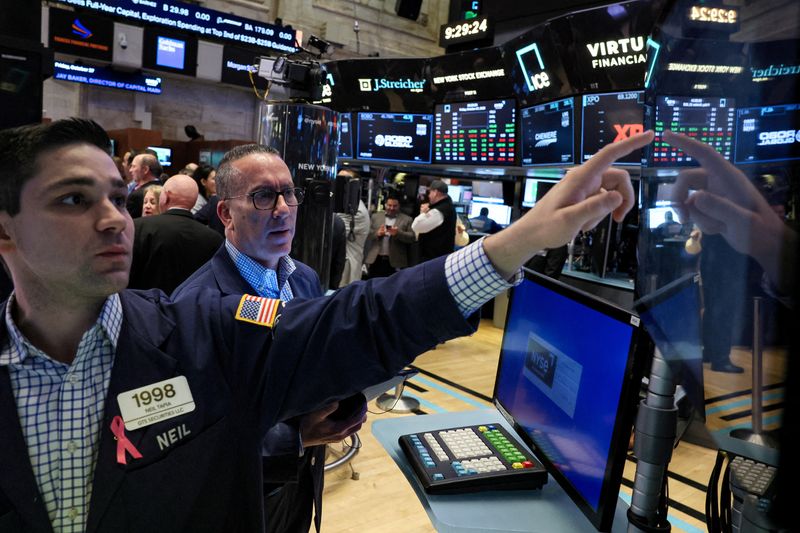By Sinéad Carew and Amruta Khandekar
(Reuters) - Wall Street's three major stock averages closed higher on Monday with Nasdaq's 1% rally leading the charge as heavyweight Microsoft (NASDAQ:MSFT) hit a record high after it hired prominent artificial intelligence executives.
The Nasdaq boasted its highest closing level since July 31 while the S&P 500 registered its highest close since Aug. 1.
The S&P 500's information technology sub-index ended up 1.5% and was the top gainer among the S&P 500's 11 major sectors. Its biggest boost came from Microsoft shares which touched a record high and ended up 2%.
Microsoft CEO Satya Nadella said Sam Altman, who headed OpenAI until he was ousted late last week, was set to join Microsoft to lead a new advanced AI research team. Microsoft will also take on Greg Brockman, another OpenAI cofounder, as well as other researchers.
The news set a positive tone for the market with other heavyweight technology stocks including Nvidia and Apple (NASDAQ:AAPL) also gaining ground.
Investors have been cheering a better-than-expected earnings season and the ongoing trend of falling Treasury yields, said Bruce Zaro, managing director at Granite Wealth Management in Providence, Rhode Island.
"The market likes what it sees in the behaving bond market. It likes what it sees in earnings reports and it's in the holiday mood," said Zaro, noting that investors may be preparing for a rally which often comes with the year-end holiday season.
The Dow Jones Industrial Average rose 203.76 points, or 0.58%, to 35,151.04, the S&P 500 gained 33.36 points, or 0.74%, at 4,547.38 and the Nasdaq Composite added 159.05 points, or 1.13%, at 14,284.53.
The Dow posted its highest closing level since Aug. 9. The benchmark S&P 500 ended less than 1% below its 2023 closing peak reached in late July.
Wall Street's main indexes have staged a rebound so far in November, after about three months of weakness, as evidence of easing U.S. inflation has supported bets that the Federal Reserve was done raising interest rates.
The defensive utilities index was the weakest among the S&P 500's 11 major sectors, ending down 0.3% followed by consumer stables, which closed down 0.01%.
While trading volume is often thin ahead of Thursday's U.S. Thanksgiving holiday, investors will have at least two potential catalysts to monitor.
One is the quarterly report, due out on Tuesday from chip designer Nvidia , whose stock is seen as one of the best ways to bet on the emerging artificial intelligence industry. Nvidia's results will wrap up the earnings season for the so-called "Magnificent Seven" group of megacap companies.
Also on Tuesday, the Fed is expected to issue minutes of its November meeting, which may provide clues on the direction of U.S. interest rates.
Traders have nearly fully priced in the likelihood that the Fed will keep interest rates unchanged in December, and some have started pricing in rate cuts as soon as March, according to the CME Group's (NASDAQ:CME) FedWatch tool.
Capping off the week, foot traffic at stores on Black Friday could provide a gauge on the state of U.S. consumer spending.
Among individual movers, Bristol Myers Squibb fell 3.8% as Germany's Bayer (ETR:BAYGN) on Sunday stopped a late-stage trial testing a new anti-clotting drug, hurting investor confidence in all firms developing similar class of drugs.
Boeing (NYSE:BA) rose 4.6% after Deutsche Bank (ETR:DBKGn) upgraded the aerospace company to "buy" from "hold" and raised its price target to $270 from $204.
Advancing issues outnumbered decliners on the NYSE by a 2.17-to-1 ratio; on Nasdaq, a 1.66-to-1 ratio favored advancers.

The S&P 500 posted 29 new 52-week highs and one new low; the Nasdaq Composite recorded 78 new highs and 90 new lows.
On U.S. exchanges 10.1 billion shares changed hands compared with the 11.0 billion moving average for the last 20 sessions.